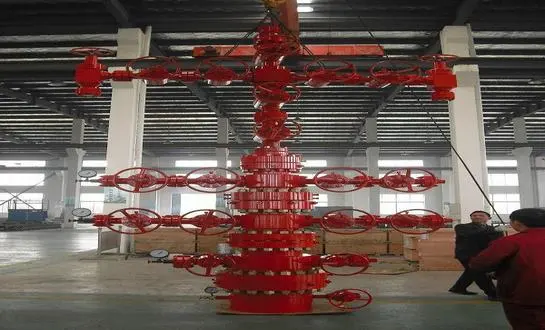Understanding the Oil Christmas Tree and Its Components
Before delving into the installation process, it's crucial to understand what an Oil Christmas Tree is and its components. This knowledge forms the foundation for proper installation and operation.
What is an Oil Christmas Tree?
An Oil Christmas Tree, also known as a production tree, is a complex assembly of valves, spools, and fittings used to control and monitor the flow of oil or gas from a well. It's called a "Christmas tree" due to its resemblance to a decorated tree when fully assembled with its various components.
Key Components of an Oil Christmas Tree
- Master Valve: The primary control valve for the well
- Wing Valves: Control the flow of oil or gas into flowlines
- Choke: Regulates the flow rate
- Gauges: Monitor pressure and temperature
- Tubing Head: Connects the Christmas tree to the wellhead
- Casing Head: Supports the casing strings
Each component plays a crucial role in the overall function of the Oil Christmas Tree. Understanding these parts is essential for proper installation and troubleshooting.
Preparing for Oil Christmas Tree Installation
Proper preparation is key to a successful Oil Christmas Tree installation. This phase involves several critical steps to ensure safety, compliance, and efficiency throughout the process.
Site Assessment and Safety Measures
Before beginning the installation, a thorough site assessment is necessary. This includes evaluating the wellhead condition, ensuring the area is clear of obstacles, and implementing necessary safety measures. Personal protective equipment (PPE) must be worn at all times, and safety protocols should be reviewed with all personnel involved.
Equipment Inspection and Preparation
All components of the Oil Christmas Tree should be inspected for damage or defects before installation. This includes checking seals, threads, and pressure ratings. Any issues should be addressed immediately. The equipment should be cleaned and lubricated as per manufacturer specifications.
Gathering Necessary Tools and Resources
Ensure all required tools and equipment are on-site and in good working condition. This may include specialized wrenches, torque tools, lifting equipment, and pressure testing devices. Having the right tools readily available will streamline the installation process and prevent delays.
Step-by-Step Guide to Installing an Oil Christmas Tree
Now that preparations are complete, let's walk through the step-by-step process of installing an Oil Christmas Tree. This guide provides a general overview, but always refer to specific manufacturer instructions and industry standards for your particular equipment.
Step 1: Mounting the Tubing Head
The tubing head is the foundation of the Oil Christmas Tree. It's typically installed on top of the casing head. Ensure proper alignment and secure it tightly using the appropriate bolts and gaskets.
Step 2: Installing the Master Valve
The master valve is mounted on top of the tubing head. This valve is critical for controlling well flow, so ensure it's properly aligned and securely fastened. Test the valve operation before proceeding.
Step 3: Attaching Wing Valves and Choke
Next, install the wing valves on either side of the tree. These control the flow into production lines. The choke is then installed to regulate flow rates. Ensure all connections are tight and properly sealed.
Step 4: Installing Gauges and Monitoring Equipment
Pressure and temperature gauges are crucial for monitoring well conditions. Install these as per the design specifications, ensuring they're easily readable and properly calibrated.
Step 5: Connecting Flow Lines
Connect the flow lines to the wing valves. These lines carry the oil or gas to processing facilities. Ensure all connections are secure and properly pressure-rated.
Step 6: Pressure Testing
Once all components are installed, conduct a thorough pressure test of the entire system. This is crucial for identifying any leaks or weak points before putting the tree into operation.
Step 7: Final Checks and Documentation
Perform a final walkthrough to ensure all components are correctly installed and functioning. Document all installation details, including torque values, pressure test results, and any issues encountered during the process.
Conclusion
Installing an Oil Christmas Tree properly is a complex but crucial process in oil and gas production. It requires careful planning, precise execution, and strict adherence to safety protocols and industry standards. By following the steps outlined in this guide and always prioritizing safety, you can ensure a successful installation that will contribute to efficient and safe well operations. Remember, while this guide provides a general overview, always consult specific manufacturer instructions and seek expert assistance when needed. Proper installation not only ensures the longevity of your equipment but also plays a vital role in maintaining the safety and productivity of your oil and gas operations.
FAQ
1. How long does it typically take to install an Oil Christmas Tree?
The installation time can vary depending on the complexity of the system and site conditions. On average, it can take anywhere from 1-3 days for a standard installation, assuming all preparations are complete and no unforeseen issues arise.
2. What are the most common issues encountered during Oil Christmas Tree installation?
Common issues include alignment problems, leaks during pressure testing, and difficulties in achieving proper torque on connections. Weather conditions can also pose challenges, especially in offshore installations.
3. How often should an Oil Christmas Tree be inspected after installation?
Regular inspections are crucial for maintaining the integrity of the Oil Christmas Tree. Typically, visual inspections should be conducted daily, with more comprehensive inspections and maintenance performed quarterly or annually, depending on the operating conditions and regulatory requirements.
Choose WELONG for Your Oil Christmas Tree Needs
When it comes to Oil Christmas Tree installation and supply, WELONG stands out as a trusted industry leader. With over 20 years of experience in oilfield equipment manufacturing, we offer unmatched expertise and quality in our products and services. Our Oil Christmas Trees are designed for reliability, efficiency, and ease of installation, meeting the highest industry standards including ISO 9001:2015 and API 7-1 certifications.
At WELONG, we understand the critical nature of Oil Christmas Tree installation and offer comprehensive support throughout the process. Our team of experts is ready to assist you with technical guidance, ensuring a smooth and safe installation. We pride ourselves on our strict quality control processes, timely delivery, and exceptional after-sales service.
For all your Oil Christmas Tree needs, trust WELONG to deliver superior products and support. Contact us today at oiltools15@welongpost.com to learn more about our Oil Christmas Tree solutions and how we can support your oil and gas operations.
Looking for a reliable Oil Christmas Tree supplier? Look no further than WELONG - your partner in oilfield excellence.
References
- Smith, J. (2022). "Advanced Techniques in Oil Christmas Tree Installation." Journal of Petroleum Engineering, 45(3), 78-92.
- Johnson, A. et al. (2021). "Safety Considerations in Wellhead Equipment Installation." Offshore Technology Conference Proceedings, Houston, TX.
- Brown, R. (2023). "Innovations in Oil Christmas Tree Design and Installation." SPE Annual Technical Conference and Exhibition, Denver, CO.
- International Association of Oil & Gas Producers. (2022). "Guidelines for Wellhead and Christmas Tree Equipment Installation." IOGP Report 512.
- American Petroleum Institute. (2021). "Specification for Wellhead and Christmas Tree Equipment." API Specification 6A, 21st Edition.
- Department of Energy. (2023). "Best Practices for Oil and Gas Well Equipment Installation." DOE/FE-0567.





